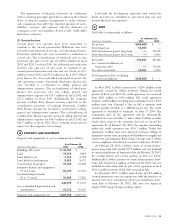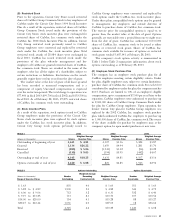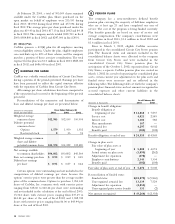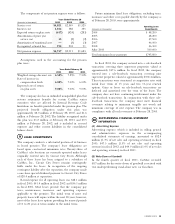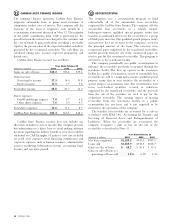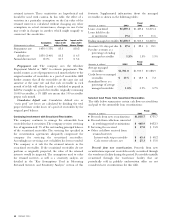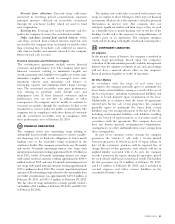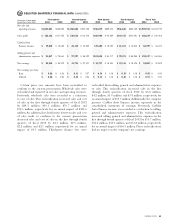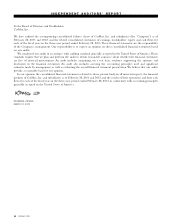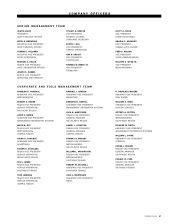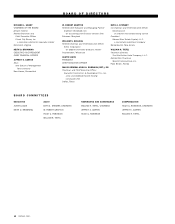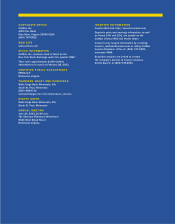CarMax 2003 Annual Report Download - page 43
Download and view the complete annual report
Please find page 43 of the 2003 CarMax annual report below. You can navigate through the pages in the report by either clicking on the pages listed below, or by using the keyword search tool below to find specific information within the annual report.
CARMAX 2003 41
Retained Interests
The company retains various interests in the automobile loan
receivables that it securitizes.The retained interests, presented
on the company’s consolidated balance sheets, serve as a
credit enhancement for the benefit of the investors in the
securitized receivables. These retained interests include the
present value of the expected residual cash flows generated by
the securitized receivables, or “interest-only strip receivables,”
the restricted cash on deposit in various reserve accounts and
an undivided ownership interest in the receivables securitized
through the warehouse facility, or “required excess
receivables” as described below.The qualified special purpose
entities and the investors have no recourse to the company’s
assets beyond the retained interests.The value of the retained
interests may fluctuate depending upon the performance of
the securitized receivables. Retained interests balances
consisted of the following:
As of February 28
(Amounts in millions) 2003 2002
Interest-only strip receivables $ 88.3 $ 74.3
Restricted cash 33.3 34.7
Required excess receivables 13.4 11.7
Total $135.0 $120.7
The retained interests had a weighted average life of 1.6
years as of February 28, 2003, and February 28, 2002. As
defined in SFAS No. 140, the weighted average life in
periods (for example, months or years) of prepayable assets is
calculated by summing the product (a), the sum of the
principal collections expected in each future period, times
(b), the number of periods until collection, and then
dividing that total by (c), the initial principal balance.
Interest-only strip receivables. Interest-only strip
receivables represent the present value of residual cash flows
the company expects to receive over the life of the
securitized receivables. The value of these receivables is
determined by estimating the future cash flows using
management’s projections of key factors, such as finance
charge income, default rates, prepayment rates and discount
rates appropriate for the type of asset and risk.The value of
interest-only strip receivables may be affected by external
factors, such as changes in the behavior patterns of
customers, changes in the strength of the economy and
developments in the interest rate markets; therefore, actual
performance may differ from these projections. Management
evaluates the performance of the receivables relative to these
assumptions on a regular basis. Any financial impact resulting
from a change in performance is recognized in earnings in
the period in which it occurs.
Restricted cash. Restricted cash represents amounts on
deposit in various reserve accounts established for the benefit
of the securitization investors.The amounts on deposit in the
reserve accounts are used to pay various amounts, including
principal and interest to investors, in the event that the cash
generated by the securitized receivables in a given period is
insufficient to pay those amounts. In general, each of the
company’s securitizations requires that an amount equal to a
specified percentage of the initial receivables balance be
deposited in a reserve account on the closing date and that
any excess cash generated by the receivables be used to fund
the reserve account to the extent necessary to maintain the
required amount. If the amount on deposit in the reserve
account exceeds the required amount, an amount equal to
that excess is released through the qualified special purpose
entity to the company. In the public securitizations, the
amount required to be on deposit in the reserve account
must equal or exceed a specified floor amount. The reserve
account remains at the floor amount until the investors are
paid in full, at which time the remaining reserve account
balance is released through the qualified special purpose
entity to the company. The amount required to be
maintained in the public securitization reserve accounts may
increase depending upon the performance of the securitized
receivables. Generally, restricted cash reserves range between
2.0% and 2.5% of managed receivables.
Required excess receivables. The warehouse facility
requires that the total value of the securitized receivables
exceed, by a specified amount, the principal amount owed to
the investors. The required excess receivables balance
represents this specified amount. Any cash flows generated
by the required excess receivables are used, if needed, to
make payments to the investors.
Key Assumptions Used in Measuring Retained Interests and
Sensitivity Analysis
The following table shows the key economic assumptions
used in measuring the fair value of the retained interests at
February 28, 2003, and a sensitivity analysis showing the
hypothetical effect on the interest-only strip receivables if
there were unfavorable variations from the assumptions
used. Key economic assumptions at February 28, 2003, are
not materially different from assumptions used to measure
the fair value of retained interests at the time of
securitization. The company has modified some of the key
economic assumptions at February 28, 2003, from the initial
assumptions used to measure the fair value of retained
interests at the time of securitization. Increases in loss rates
and decreases in prepayment speeds were substantially
offsetting resulting in no material change in the value of






